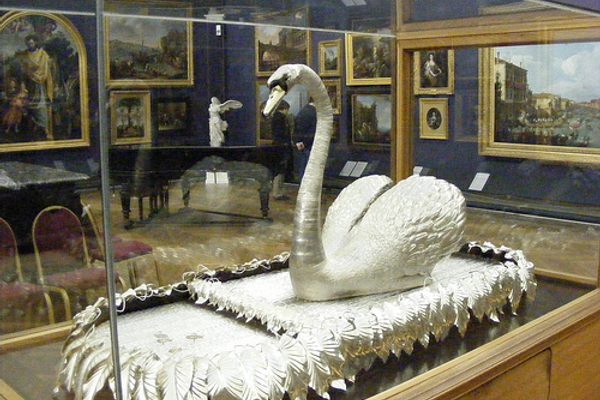Five Astounding Animal Automata
The Peacock Clock in Russia (via Wikimedia)
From man-eating tigers to the most elegant of robotic birds, some of the earliest automata were tributes to the wonders of the animal kingdom. Here are five of the most astounding mechanical animals from around the world, some centuries old. Be sure to watch the videos to see these bestial objects spring into surprising life.
THE SILVER SWAN
Bowes Museum, Barnard Castle, England
photograph by Andrew Curtis
Year: 1773
Animal Action: The life-size swan moves its delicate neck and attempts to eat silver fish that swim by it in a 40 second performance.
Secrets: It works a bit like a clock that is wound up with internal gears.
Home: Bowes Museum in Barnard Castle, England, where it still operates once a day.
TIPU’S TIGER
Victoria & Albert Museum, London, England
Year: 1793, India
Animal Action: The nearly life-size tiger attacks a man in European dress who flings his arms around in pain.
Secrets: An organ hidden in the tiger’s body plays screechy music meant to sound like the man’s dying screams.
Home: Victoria & Albert Museum in London, England, although it is too fragile for frequent animations and is only demonstrated on special occasions.
THE PEACOCK CLOCK
The State Hermitage Museum, Saint Petersburg, Russia
photograph by Harvey Barrison
Year: 1777, created by James Cox
Animal Action: Three life-size birds — a peacock, an owl, and a rooster — spring into life singing songs and fluidly moving their bodies. The owl twists its head adorned with glassy eyes, the peacock slowly and grandly lifts its wide tail and turns its neck with lifelike elegance until it flips around to display its full fan of metal feathers, while the rooster crows below.
Secrets: The clock dial is actually a metal mushroom embedded in the intricate clock scene.
Home: The State Hermitage Museum, Saint Petersburg, Russia, where it still operates.
(Skip to 0:56 in the video below for the clock action)
THE DEFENDER OF TIME
Paris, France
photograph by the author
Year: 1979, created by automaton artist Jacques Monestier
Animal Action: Although the clock has been frozen now in its public Paris perch since July 1, 2003, when it worked it was a wonder of movement. Depending on the hour of the day, a dragon, crab, or rooster would lunge at the hollow-eyed metal knight, except at three times in the day when they would all attack at once.
Secrets: The animals are meant to represent the earth, air, and sea, and originally there was a recorded soundtrack that droned the noises of rumbling land, howling wind, and crashing waves.
Home: Quarter of the Clock in Paris, France, where many hope it will someday be restored.
DIGESTING DUCK
Museum of Automatons, Grenoble, France
Illustration of the duck (via Wikimedia)
Year: 1739, created by Jacques de Vaucanson
Animal Action: The life-size mechanical duck would not just move in a close robotic facsimile of avian life, it would also eat and digest kernels of grain.
Secrets: The robot of course didn’t actually break down the grain in its metal stomach but just recycled it endlessly. However, it was Vaucanson’s dearest dream to make a duck automaton that did actually eat, digest, and excrete grain like a real bird. Why is not quite clear.
Home: Alas, the digesting duck met its end in an 1889 fire, leaving just two charred wings. However, you can find a 1998 reconstruction in the Museum of Automatons in Grenoble, France.
Vaucanson duck automaton before it was destroyed (via Wikimedia)
Reconstruction:
Animal Week is November 18 - 22, 2013 on Atlas Obscura.
Join us on Facebook, Twitter (#AnimalWeek), and Tumblr for even more animal action and to share your own tales of fascinating fauna.





















Follow us on Twitter to get the latest on the world's hidden wonders.
Like us on Facebook to get the latest on the world's hidden wonders.
Follow us on Twitter Like us on Facebook